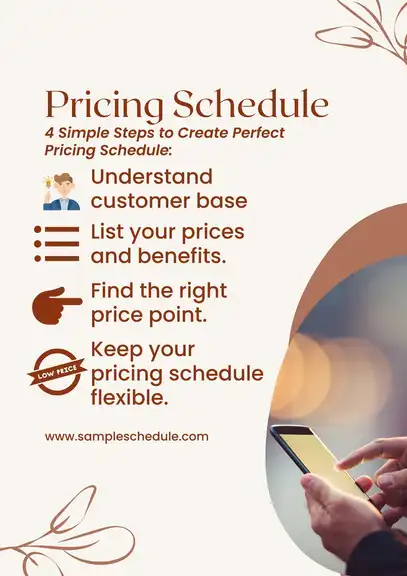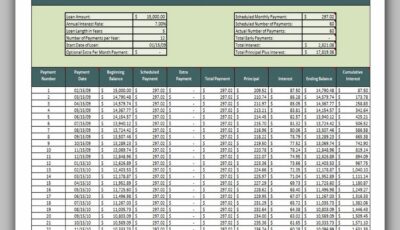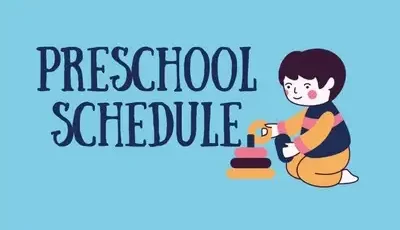You first understand your client base to create the perfect pricing schedule for your industry. With this knowledge, you can create a pricing schedule that meets their needs. Here are three simple steps to take to achieve this goal:
Understand your customer base.
When understanding your client base, first, you need to understand what they’re ready to deliver. To do this, you need to list your prices and benefits. You can find the correct price point for your industry, which will satisfy your customers while creating a profit. However, ensure that your pricing schedule is flexible and can be adjusted as needed.
List your prices and benefits.
When developing your pricing schedule, you must first list the prices of your products and services. It would help if you also listed each product’s or service’s benefits. Additionally, you should describe each product or service’s features and how it varies from your opponents. It would help if you also described the conditions under which your products and services can be operated and the associated fees.
Price Listing:
When creating your pricing schedule, you need to list the prices of your products and services. You should also briefly explain per product or service and its price. For example, you could list the prices of your products and services and their features and benefits. Additionally, you should include a brief description of how each product or service differs from your rival. This will allow you to differentiate your products and services from your rivals.
Benefits Listing:
Another important aspect of your pricing schedule is listing the benefits per product or service. It would help if you listed all the benefits of each product or service. This choice assists you in selling your products and services to possible clients.
Differentiating Your Services:
When marketing your services, you must differentiate yourself from your opponents. You can do this by listing the unique features of your services. For example, you could list the specific skills that you possess when it comes to providing services. Additionally, you could list any unique benefits associated with your services. This choice allows you to stand out from the competition.
Additional Costs:
In addition to listing the prices of your products and services, you should also include a brief description of additional costs associated with using each product or service. These costs could include installation fees, monthly subscription costs, or other related prices. By including these prices, you can guarantee that buyers know all the costs associated with employing your products and services.
Conditions Under Which Products And Services Can Be Used:
When developing your pricing schedule, it is necessary to list the situations under which each product or service can be operated. This choice assists you in deciding which products and services are best suited for which situations. For example, you may like to list the situations under which your product can be used in a company and home environment. By accomplishing this, you choose a guarantee that clients have.
Find the right price point.
Finding the right price point for your company is important. It’s founded on client requirements and wants and should be affordable for your buyers. It is also essential to comprehend your rival and find the appropriate price point for them. Adjust prices based on seasonality and what drives your product or service special. Knowing what your price point should be isn’t always easy, but with a little trial and error, you’ll find the right amount that works for you.
When creating your pricing schedule, ensure to keep it flexible. This will allow you to fulfill your customer’s needs on an individualized level. Also, communicate your pricing schedule to your customers so they know the changes that may occur. Creating a pricing schedule can be difficult, but with a little effort, it can be very prosperous for your industry.
Keep your pricing schedule flexible.
When creating a pricing schedule, it is important to be flexible to keep your customers happy. The most successful businesses are those that can change their prices frequently and adapt to the changing needs of their customer base. Being flexible will maintain a strong customer base and avoid losing them over time.
Keeping your pricing schedule flexible is also important for two other reasons. Firstly, it allows you to increase or decrease prices as needed to meet the needs of your market. Secondly, it allows you to experiment with different prices to find the best one for your business. This type of experimentation can lead to increased sales and better profits when done correctly.
There are a few things that you need to keep in mind when creating a flexible pricing schedule. First, list all your prices and benefits so that customers can see exactly what they’re getting. Secondly, be prepared to make changes often – especially during market volatility. And finally, create a process for making price changes, so everyone is on the same page.
Keeping your pricing schedule flexible is important to running a successful business. By adjusting quickly, when necessary, you will be able to keep your customers happy and ensure continued growth in your business.

4 Simple Steps to Creating the Perfect Pricing Schedule
The Different Types of Pricing Schedules
When creating a pricing schedule, you will likely have three types of pricing schedules to choose from – fixed, variable, and graduated. Each has its own set of advantages and disadvantages.
Fixed Pricing
Fixed pricing is the most common type of pricing schedule. It involves setting a certain price for every product or service. There are a few potential benefits to using a fixed pricing schedule. First, it can be easier to track your sales and inventory. Second, it can be more stable than other pricing schedules, which can help you avoid fluctuations in demand. However, a few potential drawbacks exist to using a fixed pricing schedule. For one, it can limit your ability to adjust prices as the market changes. Additionally, it may not align with customers’ preferences or needs.
Variable Pricing
Variable pricing is when prices change depending on the quantity pricing schedule or type of product or service being sold. There are a few potential benefits to using a variable pricing schedule. First, it allows you to match prices with competitors more easily. Second, it can help you manage your inventory more efficiently since you can stock more products at higher volumes without running out. However, there are several potential drawbacks to using a variable pricing schedule. For one, it can be difficult to predict future demand. Additionally, it can be tricky to set just the right prices – sometimes, customers will complain if prices are too high or low.
Graduated Pricing
Graduated pricing is a pricing schedule that starts at a lower price and gradually increases over time.
One potential benefit to using a graduated pricing scheme is that customers feel like they’re getting a discount even if the total cost remains the same over time.
Additionally, because it starts at a lower price, graduated pricing may be more popular with new customers who are unsure about what they should pay for a particular product or service.
However, there are several potential drawbacks to using a graduated pricing scheme. For one, customers may become dissatisfied if the price increases too quickly.
Additionally, graduated pricing may not be ideal for products or services with high fixed costs (like software).
In these cases, the initial cost of the product or service may be too high for customers to justify the higher total cost over time.
You can offer your customers two types of discounts with a pricing schedule – fixed discounts and variable discounts.
Fixed discounts are when the price of a product or service stays.
How to Use a Pricing Schedule
You must understand your customer base and needs when creating a pricing schedule. You can then use that information to set reasonable prices for your business.
There are a few different ways to use a pricing schedule. Some businesses choose only to use a pricing schedule when they revise their prices. Others use it as part of their daily operations, such as when deciding on a new price point or adjusting benefits.
The most important aspect of using a pricing schedule is ensuring it is flexible. You don’t want to get too rigid with your prices, or you may lose customers who can no longer afford your product or service. At the same time, you don’t want to be so flexible that you lose money on your products or services.
There are many factors to consider when creating a pricing schedule, but understanding your customer base is always key. Using a pricing schedule lets your business run smoothly and make money while keeping your customers happy.
The Advantages of a Pricing Schedule
Regarding pricing schedules, there are plenty of advantages to taking advantage of. You can improve your business’s efficiency and profitability by understanding your customer base and creating a schedule that meets their needs. Here are five of the most important benefits of using a pricing schedule:
- A pricing schedule can help you better understand your customer base. Knowing what they’re willing to pay, you can create pricing strategies that cater to their needs.
- A pricing schedule can help you to manage your business more efficiently. By setting up clear price points and limiting variation, you can limit confusion and chaos in your sales process.
- A pricing schedule can help you to create a fair price for your products and services. By breaking down prices into tiers, you can ensure that everyone in your company is fairly compensated.
- A pricing schedule can help you stay afloat during tough economic times. You can stay afloat during difficult times by ensuring that prices remain stable.
- A pricing schedule can be valuable for attracting new customers. By understanding your customer’s wants and needs, you can create marketing materials that resonate with them.
The Disadvantages of a Pricing Schedule
A pricing schedule can be difficult to change. Whenever there is a need to make changes, it can be not easy to track down all the needed information. Not only that, but it can be time-consuming to make these changes. In addition, if a change is made without properly documenting its reason, it can cause confusion among your customers.
A pricing schedule can be difficult to understand. Just like with changes, it can be hard to keep track of what is happening and to understand why certain decisions were made. This can lead to frustration on the part of your customers.
A pricing schedule can be difficult to follow. Not everyone will be able to keep up with all of the changes that are taking place. This may lead to missed opportunities or even confusion among them. Read Also: 50+ Powerful Schedule Template Excel
A pricing schedule can be difficult to maintain. Even if changes are made correctly, and documentation is kept up-to-date, it’s still possible for a pricing schedule to become outdated and ineffective over time. This can happen when new information that wasn’t considered when creating the original schedule becomes available.
How to Choose the Right Pricing Schedule
When it comes to creating a pricing schedule, it is necessary to take into account a variety of factors. Foremost among these is the competition, as well as current market conditions. Additionally, you must consider how much profit you can make from each sale and how loyal your customers may be.
If you like to begin creating a pricing schedule, the best way to do so is by analyzing your sales data. Once you understand what your clients are ready to spend for your product or service, you can begin setting prices accordingly. However, it’s important to be flexible to account for changes in the market.
If you’re looking to increase customer loyalty and repeat business, a pricing schedule can be a wonderful way. However, be sure to keep it flexible to accommodate fluctuations in demand. Choosing the right pricing schedule for your industry is an important task that requires careful consideration.
Conclusion
You must first understand your customer base to create a pricing schedule that performs best for your industry. Once you know what they’re ready to spend, you can create a pricing schedule that meets their needs.
Understanding your customer base starts with understanding their needs. You can pinpoint your client’s willingness to spend by listing your prices and benefits. Once you have a list of prices and benefits, find the right price point. Keeping your pricing schedule flexible is important to meet your customer’s needs.
There are several kinds of pricing schedules. You can pick the right one for your industry by understanding the different types. Additionally, using a pricing schedule has many benefits. Understanding the disadvantages of a schedule will help you avoid them. Finally, selecting the right pricing schedule is critical to creating a successful business.





